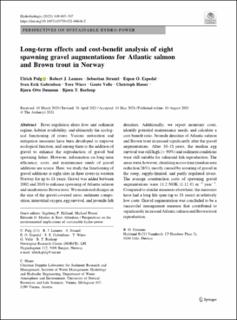| dc.description.abstract | River regulation alters flow and sediment regime, habitat availability, and ultimately the ecological functioning of rivers. Various restoration and mitigation measures have been developed to improve ecological function, and among them is the addition of gravel to enhance the reproduction of gravel bed spawning fishes. However, information on long-term efficiency, costs, and maintenance needs of gravel additions are scarce. Here, we study the functioning of gravel additions at eight sites in three rivers in western Norway for up to 18 years. Gravel was added between 2002 and 2010 to enhance spawning of Atlantic salmon and anadromous Brown trout. We monitored changes in the size of the gravel-covered areas, sediment composition, interstitial oxygen, egg survival, and juvenile fish densities. Additionally, we report monetary costs, identify potential maintenance needs, and calculate a cost-benefit ratio. Juvenile densities of Atlantic salmon and Brown trout increased significantly after the gravel augmentations. After 10–18 years, the median egg survival was still high (> 90%) and sediment conditions were still suitable for salmonid fish reproduction. The areas were, however, shrinking across time (median area reduction 26%), mostly caused by scouring of gravel in the steep, supply-limited, and partly regulated rivers. The average construction costs of spawning gravel augmentations were 11.2 NOK (1.12 €) m−2 year−1. Compared to similar measures elsewhere, the measures have had a long life span (up to 18 years) at relatively low costs. Gravel augmentation was concluded to be a successful management measure that contributed to significantly increased Atlantic salmon and Brown trout reproduction. | en_US |

